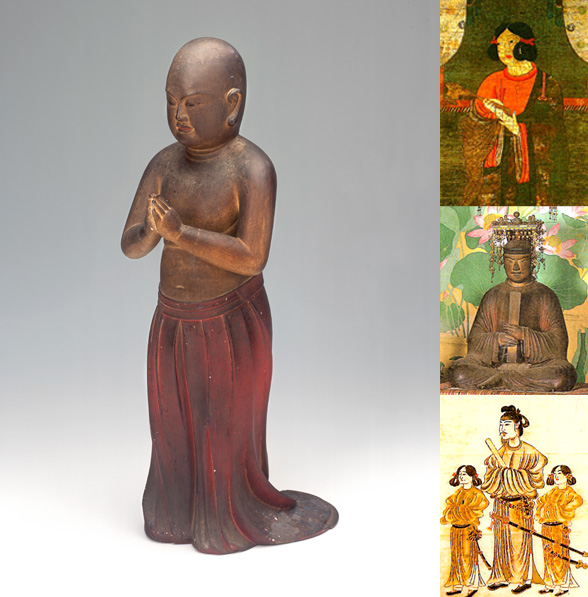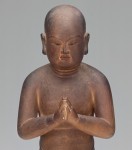
Unknown
Japanese
Prince Shōtoku Taishi as a Child Praying to the Buddha, 14th c. CE, Nambokucho period
wood with traces of polychrome, crystal eyes
19 x 7 7/8 x 9 in.
Museum purchase with funds provided by the Women's Board
2006.85

Japanese - Prince Shotoku Taishi (R)
RESEARCH PAPER
This wooden sculpture of a small boy represents one of the most revered figures in Japanese history, Prince Shotoku (574-622).
Prince Shotoku was the second son of Emperor Yomei (reigned 585-587). When imperial court politics brought his aunt, Suiko to the throne, he became crown prince and regent in 593. Buddhism was introduced to Japan through Korea in either 538 or 552, when the king of Pakche (Korea) presented a gilded bronze statue of the Buddha and sutra to the Japanese emperor, Kinmei (reigned 531 or 539-571). For half a century, the Japanese court was divided into two camps: one for Buddhism and the other against it, but in the end Prince Shotoku prevailed and set up many temples to promote Buddhism, including Horyuji Temple in Nara, built in 607, which is considered to be one of the oldest surviving wooden structures in the world. He wrote commentary on three Buddhist sutras and lectured on Buddhism. Therefore Shotoku is regarded as the founder of the Buddhist religion in Japan.
One of his accomplishments was to resume sending envoys to China, which had been discontinued since the 5th century, thus opening up the country for cultural, economic and political exchange. He invited Chinese artists, craftsmen and administraters to Japan, bringing a new political, religious and artistic institutions to Japan. After his death, he was described as a superhuman saint, or a reincarnation of Bodhisattva Guanyin in the legendary book such as Shotoku Taishi Denryaku (Biography of Prince Shotoku) and idealized portraits of Prince Shotoku were made. As the worship of Prince Shotoku spreads widely among the ordinary people, the production of the images increased dramatically from the Heian Period (9C -11C) and Kamakura Period (12C- 13C).
Portraits of the prince depict various episodes and legends about his life. There are four major categories: 1) Mantra Chanting, 2) Offering Filial Piety, 3) Lecturing on the Sutra and 4) Portrait as Regent.
These four images represent the pivotal moments in the prince's life: infancy, youth and manhood: (seen above)
1) Mantra Chanting Prince (from SBMA collection) depicts him as the age of two, when on the 15th day of the Second Month; he faced east, placed his palms together and recited the prayer. Miraculously a tiny bowl containing a relic of the Buddha appeared in his hands.
2) This image represents the prince at the age of 16 praying for the recovery of his ill father, Emperor Yomei. He is usually depicted as standing with a censer.
3) It represents an episode from Shotoku's 35 th year, when he was ordered by Empress Suiko (reigned 592 - 628) to lecture on the sutra. When he finished, huge lotus petals fell from the heaven. Suiko erected a temple on the site. The prince is depicted as being crowned and seated, usually holding a fan.
4) It shows Shotoku as regent, between the ages of 32 and 49. The oldest image of this type is from the 8 th Century, included in the Imperial Household Collection. He stands with scepter in hand, flanked by the two smaller princes. This image was used for the Japanese paper money for a long time in Showa Era (1926-1989).
During a time of political and social upheaval, such as occurred in the late Heian and early Kamakura periods, when the faithful feared that they were going through the period of degeneration of the Dharma Law, the priests of popular sects of Buddhism such as Jodo (Pure land), Shinshu (True Pure land) and Hokke used widely disseminated stories of Shotoku, venerating him as an incarnation of such important Buddhist figures as Sakyamuni, the historical Buddha. The direct connection between Shotoku and Sakyamuni provided reassuring evidence of the authenticity of Japanese Buddhism and the benefits and salvation promised specifically in the teachings of these sects.
The SBMA sculpture belongs to the group 1. The prince is portrayed as a plump little boy, with shaved head, rounded cheeks and chubby hands, wearing loose pants, which are painted red. His well-defined facial expression shows his strong will and intelligence. The wooden statue is very symmetrical. It is carved from a piece of wood and painted. Glass eyes are used to enhance naturalism.
There is a similar statue in the collection of Kawabata Yasunori, who is a Nobel Prize winning novelist (1899-1972). The wooden sculpture is about same size and regarded as the work during Kamakura Period (13C-14C). (See #2)
The SBMA statue is dated a little bit later, Nambokucho (14 th Century) than the Kawabata piece. It follows the tradition of Tempyo Art (729-749), when strong influence from the Tang Dynasty (7C-10C) sculptural style is evident in imposing, heavy and fleshy representation of body and symmetrical treatment of folds of drapery. If you compare ours to the Kawabata statue that is more natural, looking like a cute young boy,the facial features of ours seem to be more idealized, or rather godly or divinified look.
This type of sculpture was placed in a special hall called Taishi-do (Prince Hall) inside of a Buddhist temple, separate from the main buildings. Prince Shotoku is always depicted as a real human being, whether it is a child or an adult man, not as Bodhisattva, or religious icon. He was worshipped as a role model of a man who got married, had many children, lived his life, and upon his death whose soul was redeemed to the Pure land (Buddhist heaven).
Not all Shotoku statues were created by expert, Buddhist sculptors. Some are simple and naïve sculptures because they were religious icons and the quality of creativity was not always important.
We do not know who created SBMA Prince Shotoku statue, but it is a fine example of a popular religious figural sculpture from Japan.
Prepared for the SBMA Docent Council by Kyoko Sweeney in April, 2007
Selected Bibliography
Tanaka, Hisao, Nihon no Bijutsu (Japanese Art ), Tokyo Bijutsu Inc, Tokyo, 1999.
www.aisf.or.jp/~jaanus/data
Horyuji Temple, Edited by Shogakkan Inc., Tokyo, 2006
Aoyagi, Keisuke, Kawabata Collection, Geijutsu Shincho February 2007 , Shincho-sha, Tokyo, 2007
SBMA CURATORIAL LABELS
Prince Shotoku Taishi (574-622) served as a regent to Empress Suiko (reign 593-628), who promoted the Buddhist religion and firmly established its place within Japanese society. Later he was worshipped in a popular cult by all Buddhist sects as the founder of Buddhism in Japan. Votive images depicted Prince Shotoku at different periods in his life, from infancy to adulthood, each reflecting a significant event. This sculpture portrays a miraculous event that occurred when Prince Shotoku was two years old—while praying to the Buddha, a tiny vessel containing a relic of Buddha Sakyamuni appeared in his joined hands. Such a sculpture would have been placed in a Buddhist temple, most likely in a separate niche apart from the main image.
- Ridley-Tree Gallery, 2016
